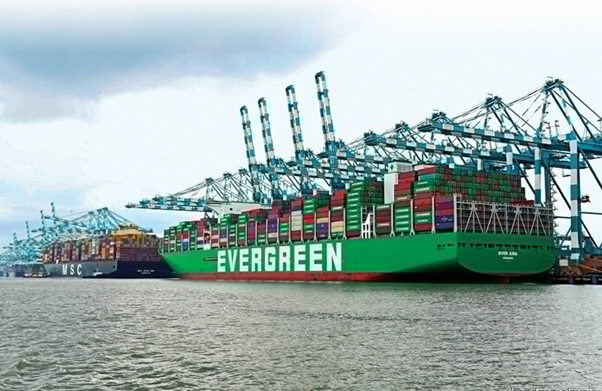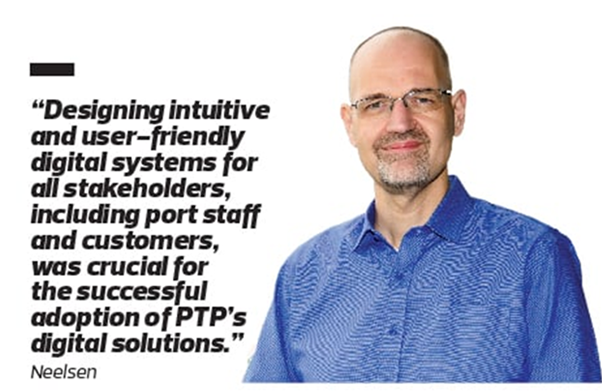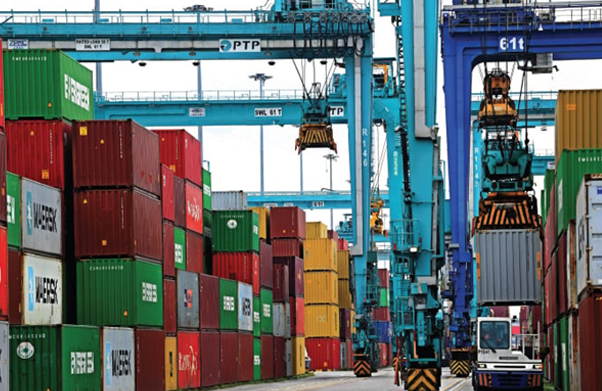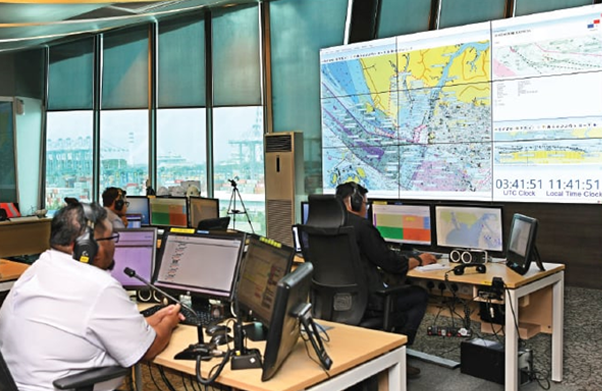PTP Charts New Course With Digital Makeover
The Edge Malaysia
View Source 
At the confluence of the main east-west shipping lanes sits the Port of Tanjung Pelepas (PTP), where huge machines such as rubber-tyred gantry (RTG) vehicles — mobile cranes that stack containers and shipping vessels — are a common sight.
With a 12.6km access channel and a turning basin of 600m, it takes shipping vessels only 45 minutes to divert into the port, making it one of the busiest container ports in the world. It is also one of the first ports in the country to digitalise and to incorporate artificial intelligence (AI) and machine learning systems.
“PTP’s process of adopting and integrating digital technologies involves using digital tools and platforms to improve business operations, increase efficiency, enhance customer experience and create new opportunities for growth and innovation,” says Marco Neelsen, CEO of PTP.

As one of the world’s largest container terminals, the port has an annual capacity of 12.5 million twenty-foot equivalent units (TEUs). The port was the first container terminal in Malaysia to surpass one million TEUs in a month.
One of the technologies used at PTP is the vessel traffic management system. The VTMS is connected to the Marine Resource Management System (MRMS) and Vessel Traffic Monitoring and Information System (VTMIS) — both of which are used to step up measures to become a “green” port. It improves the efficiency of vessel traffic movements and the safety of navigation.
The MRMS is able to integrate the entire process, from booking a berth to populating shipping registers, ordering pilots and providing vessel arrivals and departures. In 2022, PTP handled 10,608 vessel calls.
In addition to implementing the traffic management system, digital twins were incorporated to enhance efficiency. These digital replicas of the physical port use data and simulations. Functioning as computer-based models, digital twins offer real-time visualisations of the port’s operations, infrastructure and assets. This technology is harnessed for the purpose of streamlining operations, enhancing efficiency and cutting costs.
Over the next five years, says Neelsen, PTP will be spending RM3 billion to step up efforts to upgrade its current terminal footprint, including automation, digitalisation and other port functions.
PTP initiated the process of digitalisation primarily to lessen its reliance on manual procedures. The inefficiencies and errors stemming from manually managing logistics, paperwork and communication underscored the necessity for digital remedies. Moreover, dependency on manual methods resulted in elevated operational expenses, a challenge now being addressed through data-driven optimisation.
In addition, the lack of a digital system meant PTP had limited access to real-time data to handle demand and reduce congestion. The port was hindered in many ways, including in contingency planning and responsiveness to changing demands to keep up with the rapid increase in global trade, which has resulted in higher volumes and a surge in vessel traffic.
Environmental and sustainability concerns have also led to sustainability-driven decision-making.
“Traditional port operations require higher energy consumption, posing environmental, social and governance (ESG) challenges and emphasising the importance of sustainable practices. We have started using renewable energy such as solar, changing lighting to LED, using Internet of Things (IoT) and new Supervisory Control and Data Acquisition (SCADA) to improve energy efficiencies,” says Neelsen.
“PTP aims to align with ESG principles by leveraging digital solutions for informed decisions based on environmental impact assessments and resource optimisation.” SCADA controls industrial processes locally and in remote locations, and directly interacts with devices such as sensors, valves, pumps, motors and more through a human-machine interface software.
PTP is a 70:30 joint venture between MMC Corp Bhd, a utilities and infrastructure group, and APM Terminals. In 2021, MMC was reported as saying that the digital transformation to consolidate and standardise processes will also be rolled out at the other ports under its supervision, including Johor Port Bhd, Northport (M) Bhd, Penang Port Sdn Bhd and Tanjung Bruas Port Sdn Bhd.
“As a shareholder of PTP, MMC plays a crucial role in supporting and driving the PTP digitalisation efforts. MMC’s expertise in various sectors, including infrastructure and logistics, ideas and knowledge sharing can contribute to PTP’s digital transformation,” says Neelsen.
“APMT brings significant knowledge and experience in digitalising port processes. Their expertise contributes to shaping PTP’s digital strategies and implementing industry best practices.”

OVERCOMING CHALLENGES
Digitalising the port came, however, with a host of challenges. The first hurdle was the implementation of a digital system that required dealing with complex technologies, integrating existing systems, and ensuring compatibility with diverse hardware and software. Then, problems came in the selection of the correct vendor and partnerships.
“Ensuring that digitalisation efforts could accommodate future growth and technological advancements without becoming obsolete was a significant challenge,” says Neelsen.
Cybersecurity and data security was another roadblock that PTP encountered, as handling vast amounts of sensitive data raised concerns about data breaches, cyberattacks and potential privacy violations in the port’s digitalisation process.
Identifying user experience and improving usability while overcoming cultural barriers were also issues. “Designing intuitive and user-friendly digital systems for all stakeholders, including port staff and customers, was crucial for the successful adoption of PTP’s digital solutions. [Furthermore], creating a culture of innovation and adaptability within the port organisation was essential to overcoming resistance and driving the successful adoption of digital solutions in PTP,” says Neelsen.
To adapt to the digitalised environment of PTP, its employees were required to undergo talent and skills development in key areas such as data analytics, IoT, cybersecurity awareness and software applications and proofs of concept (PoCs).
Training in data analysis, data visualisation and interpreting key performance indicators enables employees to make informed decisions based on data-driven insights. On the other hand, understanding IoT devices, sensors, data collection and data interpretation helps employees effectively manage interconnected devices in PTP’s operations.
“Employees must be educated on cybersecurity best practices to recognise cyberthreats, handle sensitive data securely and maintain a strong cybersecurity posture,” says Neelsen.
“Training on specific software applications such as terminal operating systems (TOS), enterprise resource planning (ERP) and data analytics tools, along with PoC opportunities, equips employees with the necessary skills to work with digital technologies. Introduction to AI, automation and robotic areas prepares PTP employees to work alongside AI and automation technologies, streamlining processes and improving efficiency.”
PTP uses the labour management system to effectively forecast labour requirements. Thereafter, staff schedules are established and managed to accomplish daily tasks. As at March 31 last year, 4,233 PTP operational staff members were using the system.
Collaborations were key in the success of digitalising at PTP, notes Neelsen. They were carried out with technology vendors, research institutions and academic organisations, port authorities and shipping lines, customs authorities, internal operators, and environmental and sustainability organisations.
For instance, PTP is exploring potential mobility solutions for its existing terminal tractors, with Terberg Benschop as the auto-solution provider. Its Malaysian joint-venture company, Terberg Tractors Malaysia Sdn Bhd (TTM), will be the equipment manufacturer.
TTM will conduct PoCs to ascertain the viability of the autonomous mobility solutions for the equipment for PTP.
In another collaboration, PTP implemented Navis RTG Optimisation to enhance its RTG crane fleet and reduce handling costs per TEU. Navis is a global provider of port and terminal and operating systems.
“RTG Optimisation processes multiple dynamic business rules and complex operating constraints to automate execution decisions, increase crane productivity and improve operating efficiency,” says PTP’s website.
In addition, port information management system provider Innovez One supplies PTP ports with the MarineM, which is powered by AI and machine learning. The system can reallocate resources in the event of a vessel’s change in estimated time of arrival. It also includes a live map where port managers will be able to view the movements of each vessel.
IMPROVEMENTS WITH DIGITALISATION
Digitalisation in the port has seen improvements in several areas including increased efficiency, a positive impact on employees and a reduction in operational costs.
“Digitalisation has provided PTP with real-time data on vessel movements, container status and overall terminal operations. This has enabled better planning and decision-making, leading to more efficient handling of incoming and outgoing vessels,” says Neelsen.
In addition, automated processes and predictive analysis have also increased efficiency. Predictive analysis allows PTP to anticipate demand, optimise resource allocation and address bottlenecks resulting in smoother operations.
With digitalisation, employees see enhanced job roles, reskilling opportunities and improved safety, adds Neelsen.
For example, PTP uses an application to identify situations in which drivers feel drowsy or fatigued. In these instances, the drivers are alerted and reminded to pull over to the side and take the necessary steps to ensure their safety, alongside the safety of other drivers.
This is especially important, as an average of 450 prime movers are deployed during a shift.
“[Technology] can support social responsibility by enabling communication and collaboration among employees, customers and stakeholders. For example, [technology] can provide platforms for employees to share knowledge and expertise, promote diversity and inclusion initiatives, and support remote work arrangements to promote work-life balance,” asserts Neelsen.
PTP is also looking into AI and machine learning to analyse big data to better predict vessel arrivals, using autonomous vehicles for container transportation and drones for inspections and monitoring as well as augmented and virtual reality for employee training and equipment maintenance.
Having seen how PTP has benefited from digitalisation, Neelsen offers advice for companies embarking on a similar venture. It includes conducting a comprehensive digital assessment to identify areas to improve; setting clear objectives and measurable KPIs to gauge the success of digital projects; engaging stakeholders; investing in digital talent and training to equip the workforce with digital skills; and prioritising robust cybersecurity measures to protect against cyberthreats and data breaches in the digital environment.
“PTP often shares best practices and experiences with its counterparts through industry conferences, workshops and forums. As PTP has successfully implemented digital efforts, it shares its success stories, challenges and lessons learned with ports under MMC ports or others that are interested in digitalisation,” says Neelsen.
USING TECHNOLOGY THROUGHOUT THE SHIPPING PROCESS
For the Port of Tanjung Pelepas (PTP), digitalisation is an all-encompassing effort that permeates the entire organisation.
The Terminal Operation System (TOS), smart applications, asset digitalisation and a marine resource management system (MRSM) are used for operations management to efficiently manage port equipment facilities, container handling, berth facilities, quayside and the container yard.
The smart applications are used to optimise planning, visibility and asset utilisation of twist locks, reefers, hatch clerks and lashing. Other apps include PTP Connect, which provides the workforce with mobile productivity tools, and an incentive app.
Asset digitalisation is integral to the process. It provides live equipment tracking and monitoring systems, which are installed on 58 quay cranes, 172 rubber-tyred gantries and 596 prime mover and OPS vehicles. It also provides up-to-date prime mover global positioning system (GPS) positions to the TOS. It will then optimise the dispatch for the prime mover.

“The system optimises the movement of containers within the port, reducing fuel consumption and greenhouse gas emissions. For instance, the system uses route optimisation to reduce the number of trucks needed to move containers or implements smart traffic management systems to reduce congestion,” says Marco Neelsen, CEO of PTP.
The technologies employed in business management are used to cope with changing markets and to automate processes.
For instance, Enterprise Resource Planning (ERP) allows PTP to organise multiple processes and manage them on a single platform. It comprises human capital management, finance, supply chain engineering, project integration and reefer modules.
Furthermore, data lakes and analytics provide a storage repository with analytics.
“Data lakes allow for the consolidation of large amounts of data from various sources, providing organisations with a holistic view of their operations. With this information, organisations can make data-driven decisions that support sustainable practices, such as reducing energy consumption or waste,” says Neelsen.
The other systems used include integrated document management, integrated intelligent security system and continuous cybersecurity improvement.
PTP has 4,784 reefer points, which are used for storage of refrigerated containers. As such, the smart reefer technology is used to reduce energy consumption in reefer areas with dashboard monitoring. This technology is part of the technology associated with sustainability and environment.
The port also uses technology to ensure energy efficiency and protection of the maritime environment.
Finally, technology is also used for trade and transport management to facilitate smart and secure exchange of information between all parties in the port and logistics chain. These technologies are TradeLens, terminal activity reconciliation and terminal gate automation. TradeLens, which allows PTP to view shipping events, and terminal activity reconciliation use blockchain technology. — By Kiran Jacob